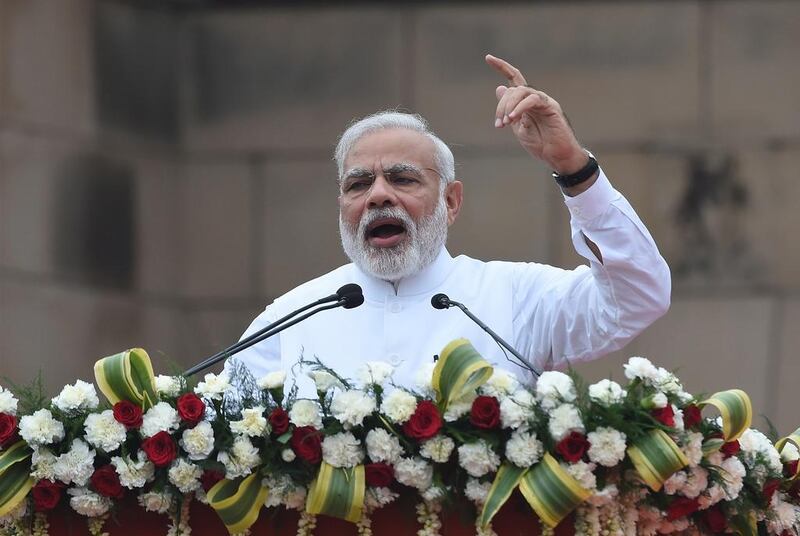It is a year since the United Arab Emirates occupied centre stage at India's Republic Day parade. This year an unprecedented group of ten Southeast Asian leaders assembled in New Delhi on January 26.
The gathering, while celebrating the 69th anniversary of the Indian constitution, also marked 25 years of India’s partnership with Asean (Association of Southeast Asian Nations).
By forging strategic ties with several countries of "West Asia" (as India refers to the Middle East) in recent years and upgrading its relations with the Asean bloc, India has skillfully enacted both its "Think West" and "Act East" diplomatic outreach.
Explaining this approach, the Indian Foreign Secretary, S Jaishankar, said: "If the eastern front is building upon longstanding policy, the western one is relatively more recent conceptually, even if India has had a historical presence in the Gulf…I can confidently predict that 'Act East' would be matched with 'Think West.'"
While PV Narasimha Rao, Indian prime minister from 1991 to 1996, was the architect of the "Look East" policy, Prime Minister Narendra Modi's government redefined it in 2015, while also transforming its strategy on the Middle East.
Linking this to the region, it is pertinent to point out that India’s "Think West" policy prudently reciprocates the Gulf countries’ "Look East" initiative of the last two decades.
As part of India's renewed efforts towards the Middle East, Mr Modi visited the UAE, Saudi Arabia, Qatar, Iran, Israel and Turkey. New Delhi has also hosted the leaders of the UAE, Qatar, Turkey and Israel, among others, during the last four years.
The fact that Israeli Prime Minister Benjamin Netanyahu's visit to India came within a fortnight of New Delhi's UN vote against Washington's recognition of Jerusalem as Israel's capital, is indicative of India's diplomatic pragmatism. This is reinforced by the fact that Mr Modi is scheduled to become the first Indian prime minister to visit Palestine in February.
Along with the west-east strategies, there is also the "Neighbourhood First Policy" that set the tone for the new government in 2014, with South Asian leaders attending the prime minister’s swearing-in ceremony. Add to it the "Connect Central Asia" policy, and there is a pattern of calibrated proactive Indian diplomacy at play in Asia.
____________
Read more from Opinion
[ US trade deals are the key to understanding Trump's foreign policy approach ]
[ A mocha brewed with coffee beans from Mokha tastes so much better ]
[ The now-notorious Presidents Club is symbolic of the unfinished business of women’s equality ]
____________
Together, they demonstrate New Delhi’s ability to simultaneously balance its multiple and sometimes contradictory strategic interests with Russia and the United States, Israel and Palestine, as well as the Gulf Cooperation Council countries and Iran.
While energy, trade and expatriates were the primary consideration for India’s engagement with the Middle East, it has expanded to include a combination of political, economic and more importantly, security cooperation.
Mr Modi's visit to the UAE in 2015 was historic. Coming as it did 34 years after the last visit by an Indian prime minister, it laid the ground for two visits to India by Sheikh Mohammed bin Zayed in 2016 and 2017, culminating in the signing of the Comprehensive Strategic Partnership Agreement.
This momentum will be sustained with India being the guest country at the World Government Summit in the UAE, which Mr Modi will attend next month.
Amid this "Think West" strategy, India doubled up to not just "Look East, but Act East" as well. This redefinition extends India’s interaction beyond Asean and Japan “to encompass the Koreas in the north to Australia and New Zealand in the south, and from neighbouring Bangladesh to Fiji and Pacific Island countries in the Far East”.
As with the Middle East, India has also enjoyed ancient civilisational ties with Southeast Asia and is reimagining and reshaping its diplomacy with the region.
One such long-term project is the highway connecting India, Myanmar and Thailand, which would ultimately link the South and Southeast Asian economies. Similarly, some of the Gulf countries are part of the India-initiated North-South Transport Corridor.
And, like the strategic and defence cooperation ventures with the countries of the Middle East, India is also looking beyond the three Cs – commerce, culture and connectivity – that formed the foundation of India-Asean ties. Here, for example, India is reportedly considering exporting defense equipment to Vietnam.
Another feature of India's West and East Asia policies is the possibility of running against China's interests in both regions. While the occasional public posturing by both countries about stepping on each other's toes is inevitable, the final word on whether the India-China quest for influence will result in cooperation, continue with competition or end in confrontation is far from written.
However, it is important to recognise that by robustly extending India’s outreach within Asia and even to Africa, New Delhi has underlined the importance of the Indian Ocean Rim as a strategic link from the Strait of Hormuz to the Strait of Malacca.
This also underscores New Delhi’s recognition that “India and the Indian Ocean are appropriate halfway points between West and Southeast Asia”.
With US influence waning in India’s sphere of influence, New Delhi’s deft diplomacy is interesting not only in the current context, but is pregnant with possibilities in the realm of future Asian security as well.
Dr N. Janardhan is Senior Research Fellow, Gulf-Asia Programme at the Emirates Diplomatic Academy and Honorary Fellow, University of Exeter





